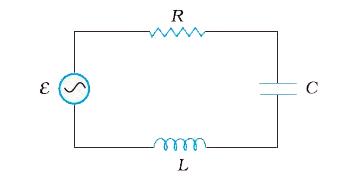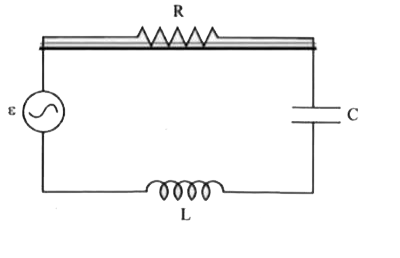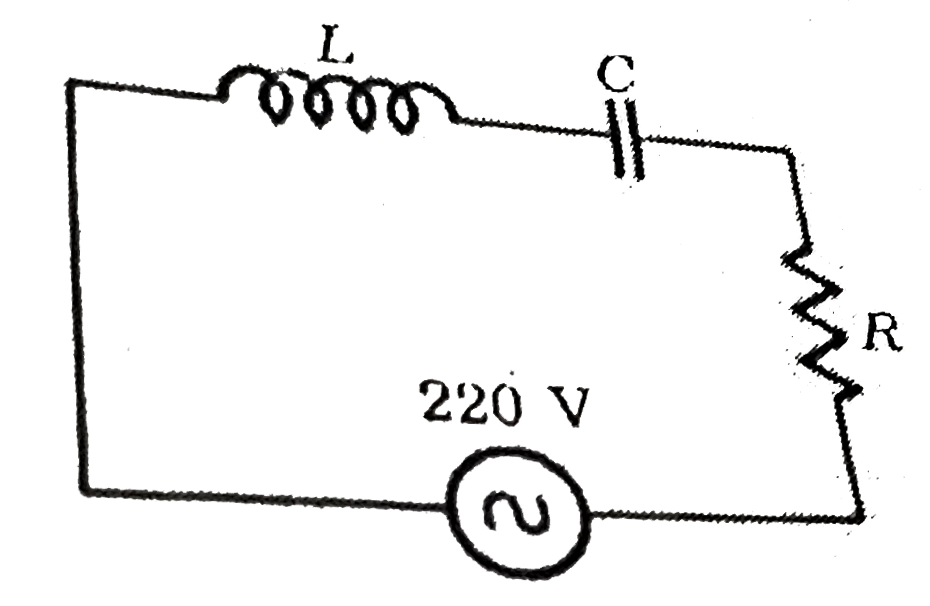The figure shows a series LCR circuit connected to a variable frequency 230 V source. a Determine the source frequency which drives the circuit in resonance. b Calculate the impedance of the circuit and amplitude of current at resonance. c Show that potential drop across LC combination is zero at resonating frequency.
P.D. across the LC – combination at the resonant frequency= Applied rms voltage = Applied rms voltage This is because the total potential drop across the LC- combination is zero
Related Solutions
Figure shows a series LCR circuit connected to a variable frequency 230 V source. .

(a) Determine the source frequency which drives the circuit in resonance.
(b) Obtain the impedance of the circuit and the amplitude of current at the resonating frequency.
(c) Determine the rms potential drops across the three elements of the circuit. Show that the potential drop across the LC combination is zero at the resonating frequency.
View SolutionFigure shows a series LCR circuit connected to a variable frequency 230 V source. L = 5.0 H, C = 80muF, R = 40 Omega . (a) Determine the source frequency which drives the circuit in resonance. (b) Obtain the impedance of the circuit and the amplitude of current at the resonating frequency. (c) Determine the rms potential drops across the three elements of the circuit. Show that the potential drop across the LC combination is zero at the resonating frequency.
View SolutionFigure shows a series LCR circuit connected to a variable frequency 230 V source. L = 5.0 H, C = 80muF, R = 40 Omega . (a) Determine the source frequency which drives the circuit in resonance. (b) Obtain the impedance of the circuit and the amplitude of current at the resonating frequency. (c) Determine the rms potential drops across the three elements of the circuit. Show that the potential drop across the LC combination is zero at the resonating frequency.
View SolutionFigure shows a series LCR circuit connected to a variable frequency 230 V source. .

Determine the source frequency which drives the circuit in resonance.
View SolutionThe given circuit diagram shows a series LCR circuit connected to a variable frequency 230 V source. Determine the source frequency which drives the circuit in resonance.

View SolutionFigure shows a series LCR circuit connected to a variable frequency 230 V source. The source frequency which drives the circuit the circuit in resonance is
View SolutionFigure shows a series LCR circuit connected to a variable frequency 230 V source. The source frequency which drives the circuit the circuit in resonance is
View SolutionThe diagram shows that a series LCR circuit is connected to a variable frequency 230 V source. Then the source frequency that brings the circuit into resonance -
View SolutionFigure shows a series LCR circuit connected to a variable frequency 230 V source.

a. Determine the source frequency which drives the circuit in resonance
b. Obtain the impedance of the circuit and the amplitude of current at the resonating frequency.
c. Determine the rms potential drops across the three elements of the circuit. Show that the potential drop across the LC combination is zero at the rasonating frequency .
View Solutionएक श्रेणी LCR परिपथ में तथा 60Omega को 240V वोल्ट के परिवर्ती आवृत्ति के प्रत्यावर्ती धारा स्त्रोत से जोड़ा गया है । गणना कीजिए -(i ) स्त्रोत की कोणीय आवृत्ति जो परिपथ को अनुनाद की अवस्था में लाती है ,(ii ) अनुनादी आवृत्ति पर धारा , (iii ) प्रेरक के सिरों के बीच अनुनाद की दशा में वर्ग - माध्य - मूल विभव पतन ।
View SolutionFigure here, shows a series L-C-R circuit connected to a variable frequency 230 V source. L = 5.0H, C = 80 muF and r = 40 Omega (a) Determine the source frequency which drives the circuit in resonance. (b) Obtain the impedance of the circuit and the amplitude of current at the resonating frequency. (c) Determine the rms potential drops across the three elements of the circuit. show that the potential drop across the L-C combination is zero at the resonating frequency.
View SolutionFigure here, shows a series L-C-R circuit connected to a variable frequency 230 V source. L = 5.0H, C = 80 muF and r = 40 Omega (a) Determine the source frequency which drives the circuit in resonance. (b) Obtain the impedance of the circuit and the amplitude of current at the resonating frequency. (c) Determine the rms potential drops across the three elements of the circuit. show that the potential drop across the L-C combination is zero at the resonating frequency.
View SolutionThe given circuit diagram shows a series LCR circuit connected to a variable frequency 230 V source. Obtain the impedacne of the circuit and the amplitude of current at resonating frequency.
View SolutionA series LCR circuit connected to a variable frequency 230 V source has L = 5.0 H, C = 80 mu F , R = 40 Omega , Fig. (a) Determine the source frequency which drives the circuit in resonance. (b) Obtain the impedance of the circuit and amplitude of current at at resonating frequency. (c ) Determine the r.m.s. potential drops acorss the three elements the circuits. Show that the potential drop acorss the LC combination is zero at the resonating frequecny.
View SolutionA series LCR circuit connected to a variable frequency 230 V source has L = 5.0 H, C = 80 mu F , R = 40 Omega , Fig. (a) Determine the source frequency which drives the circuit in resonance. (b) Obtain the impedance of the circuit and amplitude of current at at resonating frequency. (c ) Determine the r.m.s. potential drops acorss the three elements the circuits. Show that the potential drop acorss the LC combination is zero at the resonating frequecny.
View SolutionFigure shows a series LCR circuit connected to a variable frequency 230 V source. L = 5.0 H, C = 80 mu F, R = 40 Omega . Determine the rms potential drops across the three elements of the circuit. Show that the potential drop across the LC combination is zero at the resonating frequency.
View SolutionFigure shows a series LCR circuit connected to a variable frequency 230 V source. L = 5.0 H, C = 80 muF , R= 40 Omega . Determine the rms potential drops across the three elements of the circuit. Show that the potential drop across the LC combination is zero at the resonating frequency. :
View SolutionFig 14.18 shows a series LCR circuit connected to a variable frequency 200 V source:
and .
(i) Calculate the resonant frequency of the circuit.
(ii) Obtain the impedance of the circuit and the amplitude of the current at resonating frequency.
(iii) Determine r.m.s. potential drop across L.

View SolutionFigure 7.21 shows a series LCR circuit connected to a variable frequency 230 V source. L = 5.0 H, C = 80 muF , R= 40 Omega . Determine the source frequency which drives the circuit in resonance. :
View SolutionFigure shows a series LCR circuit connected to a variable frequency 230 V source. .

Determine the source frequency which drives the circuit in resonance.
View Solution